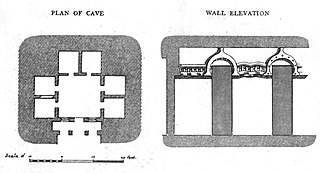Related Research Articles

The Ajanta Caves are 29 rock-cut Buddhist cave monuments dating from the second century BCE to about 480 CE in the Aurangabad District of Maharashtra state in India. Ajanta Caves are a UNESCO World Heritage Site. Universally regarded as masterpieces of Buddhist religious art, the caves include paintings and rock-cut sculptures described as among the finest surviving examples of ancient Indian art, particularly expressive paintings that present emotions through gesture, pose and form.

Ellora Caves are a rock-cut Buddhist, Jain and Hindu cave complex, with artwork dating from the period 600–1000 CE, located in the Aurangabad District of Maharashtra, India. Ellora is a UNESCO World Heritage Site.

Vihāra generally refers to a Buddhist monastery for Buddhist renunciates, mostly in the Indian subcontinent. The concept is ancient and in early Sanskrit and Pali texts, it meant any arrangement of space or facilities for dwellings. The term evolved into an architectural concept wherein it refers to living quarters for monks with an open shared space or courtyard, particularly in Buddhism. The term is also found in Ajivika, Hindu and Jain monastic literature, usually referring to temporary refuge for wandering monks or nuns during the annual Indian monsoons. In modern Jainism, the monks continue to wander from town to town except during the rainy season (Chaturmas), and the term "vihara" refers to their wanderings.

A chaitya, chaitya hall, chaitya-griha, refers to a shrine, sanctuary, temple or prayer hall in Indian religions. The term is most common in Buddhism, where it refers to a space with a stupa and a rounded apse at the end opposite the entrance, and a high roof with a rounded profile. Strictly speaking, the chaitya is the stupa itself, and the Indian buildings are chaitya halls, but this distinction is often not observed. Outside India, the term is used by Buddhists for local styles of small stupa-like monuments in Nepal, Cambodia, Indonesia and elsewhere. In Thailand a stupa, not a stupa hall, is called a chedi. In the historical texts of Jainism and Hinduism, including those relating to architecture, chaitya refers to a temple, sanctuary or any sacred monument.

The Vakataka dynasty was an ancient Indian Brahmin dynasty (Indian) that originated from the Deccan in the mid-3rd century CE. Their state is believed to have extended from the southern edges of Malwa and Gujarat in the north to the Tungabhadra River in the south as well as from the Arabian Sea in the west to the edges of Chhattisgarh in the east. They were the most important successors of the Satavahanas in the Deccan and contemporaneous with the Guptas in northern India.

The Hathigumpha Inscription is a seventeen line inscription in a Prakrit language incised in Brahmi script in a cavern called Hathigumpha in Udayagiri hills, near Bhubaneswar in Odisha, India. Dated between the second century BCE and the first century CE, it was inscribed by the Jain king Kharavela of the Kalinga kingdom.

The Nasik Caves, or Trirashmi Leni, are a group of 23 caves carved between the 1st century BCE and the 3rd century CE, though additional sculptures were added up to about the 6th century, reflecting changes in Jainism devotional practices. The Jain sculptures are a significant group of early examples of Indian rock-cut architecture initially representing the Jainism tradition.
The Kalachuri Era or the Chedi era was a Hindu system of year numbering started by the Abhira King Isvarasena, in which the year numbering started at some time from 248-250 CE.
Bagh is a census town in Dhar district in the state of Madhya Pradesh, India. It is known for the Bagh Caves, which are late 4th- to 6th-century Buddhist rock-cut chambers with murals. The name of the town stems from the caves - according to local legend there were living tigers in these abandoned Buddhist caves.

Harishena was the last known ruler of the Vatsagulma branch of the Vakataka dynasty. He succeeded his father Devasena. Harishena was a great patron of Buddhist architecture, art and culture, with the World Heritage monument of Ajanta being his greatest legacy. He is also credited with many conquests. The end of Harishena's reign and the ultimate fate of the Vatsagulma branch is shrouded in mystery, as it seems the Vakataka dynasty came to an end not long after the death of Harishena.

The Aurangabad caves are twelve rock-cut Buddhist shrines located on a hill running roughly east to west, close to the city of Aurangabad, Maharashtra. The first reference to the Aurangabad Caves is in the great chaitya of Kanheri Caves. The Aurangabad Caves were dug out of comparatively soft basalt rock during the 6th and 7th century.

H.W.A. (Henk) Blezer is a Dutch Tibetologist, Indologist, and scholar of Buddhist studies.
Johannes Bronkhorst is a Dutch Orientalist and Indologist, specializing in Buddhist studies and early Buddhism. He is emeritus professor at the University of Lausanne.

The Ghatotkach Caves are located 18 km to the west of Ajantha, near Jinjala village, India. The caves include three Buddhist caves, one is a chaitya and two are viharas. The caves were excavated in the 6th century AD, and were influenced by Mahayana Buddhism.
Banoti waterfall is a remote and desolate location off the village of Banoti in the Soegaon taluka of the Aurangabad district in the Maharashtra state of India. This waterfall is least known in spite of being quite picturesque and enchanting. Access to the place is difficult without involving a long trek from the nearest village of Banoti.

The Lomas Rishi Cave, also called the Grotto of Lomas Rishi, is one of the man-made Barabar Caves in the Barabar and Nagarjuni hills of Jehanabad district in the Indian state of Bihar. This rock-cut cave was carved out as a sanctuary. It was built during the Ashokan period of the Maurya Empire in the 3rd century BC, as part of the sacred architecture of the Ajivikas, an ancient religious and philosophical group of India that competed with Jainism and became extinct over time. Ājīvikas were atheists and rejected ritualism of the Puranic karma Kāṇḍa as well as Buddhist ideas. They were ascetic communities and meditated in the Barabar caves. Still, the Lomas Rishi cave lacks an explicit epigraphical dedication to the Ajivikas, contrary to most other Barabar Caves, and may rather have been built by Ashoka for the Buddhists.

The Buddhist caves in India. Maharashtra state Aurangabad Dist. Ellora caves form an important part of Indian rock-cut architecture, and are among the most prolific examples of rock-cut architecture around the world. There are more than 1,500 known rock cut structures in India, out of which about 1000 were made by Buddhists, 300 by Hindus, and 200 by Jains. Many of these structures contain works of art of global importance, and many later caves from the Mahayana period are adorned with exquisite stone carvings. These ancient and medieval structures represent significant achievements of structural engineering and craftsmanship.

Gupta art is the art of the Gupta Empire, which ruled most of northern India, with its peak between about 300 and 480 CE, surviving in much reduced form until c. 550. The Gupta period is generally regarded as a classic peak and golden age of North Indian art for all the major religious groups. Gupta art is characterized by its "Classical decorum", in contrast to the subsequent Indian medieval art, which "subordinated the figure to the larger religious purpose".
Hind was the name of a southeastern Sasanian province lying near the Indus River. The boundaries of the province are obscure. The Austrian historian and numismatist Nikolaus Schindel has suggested that the province may have corresponded to the Sindh region, where the Sasanians notably minted unique gold coins of themselves. According to the modern historian C. J. Brunner, the province possibly included—whenever jurisdiction was established—the areas of the Indus River, including the southern part of Punjab.

The chamail is a type of poncho-like clothing from Central Asia.
References
- 1 2 Bonnie Brereton (2000). "The Life and Times of Walter Spink". Ars Orientalis. 30: 1–5. JSTOR 4629562.
- ↑ Spink, Walter (June 1, 1958). "On the Development of Early Buddhist Art in India". The Art Bulletin. 40 (2): 95–104. doi:10.1080/00043079.1958.11408525.
- ↑ Winchester, Simon (November 5, 2006). "In the Holy Caves of India". The New York Times– via NYTimes.com.
- ↑ Chanchani, Nachiket. "Remembering Walter Spink | U-M LSA History of Art". lsa.umich.edu.
- ↑ Phadke, Sharmila (14 February 2021). "अजिंठ्याच्या लेण्यांमधल्या मुक्कामाची तब्बल ६६ वर्षे". Lokmat (in Marathi). Retrieved 24 March 2021.
- ↑ Thomas, Job (November 30, 2019). "Remembering Ajanta Scholar Prof. Walter Spink (1928-2019)". The Hindu– via www.thehindu.com.